Voltar
TROPHIC STRUCTURE OF MACROINVERTEBRATE COMMUNITIES
IN THE JAÚ RIVER SYSTEM (CENTRAL AMAZON, BRAZIL).
Eduardo Cargnin-Ferreira1, Bruce Rider
Forsberg
1Instituto Nacional de Pesquisas da Amazônia
(INPA)-CPEC, Caixa Postal 478 - 69011-970, Manaus/AM,
Brazil
1Endereço atual: Universidade Federal
de Santa Caratina, CCB, Depto. de Ciências Morfológicas.
--------------------------------------------------------------------------------
ABSTRACT
The River Continuum Concept (RCC) provides
a holistic theoretical framework for understanding the
trophic structure and functioning of fluvial ecosystems.
Macroinvertebrate functional feeding groups (FFGs) play
a key role in these systems, processing specific sizes
classes and types of organic resources in similar ways.
The RCC makes specific predictions about the spatial distributions
of FFGs along the river size-continuum. We present here
the first test of these predictions in a neotropical fluvial
ecosystem, the Jaú River. Distributions of aquatic
macroinvertebrate FFGs, determined along a continuum of
river size within the Jaú basin, were compared
to those predicted by the RCC. Aquatic macroinvertebrates
were collected in 1st, 2nd, 3rd, 4th and 7th order tributaries
of the Jaú using an optimized sampling scheme on
four distinct occasions between March and November of
1995. As expected by the RCC, the relative abundances
of most FFGs varied significantly with stream size. The
specific patterns encountered for several FFGs though
were quite distinct from those predicted by the RCC. The
communities in headwater streams, which according to the
RCC should be dominated by shredders and benthic particle
collectors, were dominated by scrapers and omnivores,
apparently feeding on fungi. The relative abundance of
predators, which is expected to be relatively constant
in the RCC, varied considerably between tributaries in
the Jaú, due primarily to differences in prey availability.
Two distinct pathways for the processing of allochthonous
particulate organic matter were identified in the Jaú
river system: 1) a dominant pathway beginning with the
colonization and consumption of leaf litter by fungi and
2) a minor pathway, initiating with the consumption of
submerged leaves by shredders.
Key words: river, macroinvertebrate,
functional feeding groups, Amazon.
--------------------------------------------------------------------------------
INTRODUCTION
Since its creation by Vannote et al. (25),
the River Continuum Concept (RCC) has become one of the
central paradigms for research on lotic macroinvertebrate
communities. The RCC provides a holistic theoretical framework
for understanding the trophic structure and functioning
of fluvial ecosystems. Macroinvertebrate functional feeding
groups (FFGs) (9) play a key role in these systems, processing
specific sizes classes and types of organic resources
in similar ways. The RCC makes
specific predictions about the spatial
distributions of FFGs in river systems. The relative abundance
of each FFG is expected to vary in a unique way in response
to systematic changes in habitat structure and resource
availability which occur between the headwaters and mouth
of a river. Shredders, which utilize whole leaves and
other large organic matter as a resource, are expected
to be more numerous in small headwater streams where these
materials tend to accumulate. Vannote et al. (25) defined
collectors as scavengers which feed on small particles
produced by shredders and other functional groups or processes
and separated them schematically into benthic and planktonic
particle feeders. Here when define these two sub-groups
as collectors and filterers, respectively. Benthic particle
feeders (collectors) are expected to reach peak densities
in small to intermediate sized tributaries where fine
benthic particulate matter is most abundant. Planktonic
particle feeders (filterers) are expected to predominate
in larger rivers where ultra-fine suspended particulate
matter, produced by the progressive reduction of organic
detritus by upstream communities, tends to accumulate.
Scrapers, which feed on periphytic algae, are expected
to be most abundant in intermediate sized streams where
reduced shading and shallow waters produce optimal light
levels for algal growth (21, 25). Predators, which feed
on prey from all functional groups, are expected to occur
uniformly throughout the river size continuum. The independent
variation in FFG distributions with stream size is expected
to produce a continuum of macroinvertebrate communities
which processes allochthonous and autochthonous carbon
inputs in an integrated sequential fashion, maximizing
the efficiency of organic carbon metabolism in the ecosystem
(25).The predictions of the RCC regarding lotic macroinvertebrate
distributions have been tested in a number of north temperate
river systems (15, 8, 4, 3). Their accuracy in neotropical
systems though has yet to be evaluated. The Amazon, the
largest neotropical river system in the world, provides
an ideal environment for such a test. Much of the Amazon
river system drains undisturbed tropical forest and still
contains a full spectrum of natural lotic habitats. The
invertebrate communities in these systems have been studied
extensively (26, 27, 16, 28, 33). However the specific
predictions of the RCC regarding FFG distributions have
never been tested explicitly. We present here an analysis
of macroinvertebrate community structure in the Jaú
river, a 7th order blackwater tributary of the Amazon.
The distributions of FFGs encountered in the Jaú
river system are compared to those predicted by the RCC.
The implications of the results for the understanding,
conservation and management of neotropical fluvial ecosystems
are discussed.
MATERIAL AND METHODS
Study site
The Jaú is a 7th order black water
tributary which flows into the right bank of the Negro
River approximately 250 km upstream from its confluence
with the Amazon main channel near Manaus. The fluvial
network of the Jaú drains approximately 10,000km2
of predominantly undisturbed lowland tropical forest which
is located entirely within the Jaú River National
Park. The Jaú main channel is a slow meandering
river with an extensive but poorly developed floodplain
covered by annually flooded forest. The 4th to 6th order
tributaries of the Jaú also have fringing forested
floodplains, although they are less extensive and subject
to more frequent flooding. The meanders in these streams
also tend to be more frequent and smaller. Large but infrequent
log dams are encountered in forth order streams and large
submerged litter banks frequently occur on the interior
margins of their meanders. The 1st to 3rd order tributaries
of the Jaú generally drain upland forests. They
are characterized by narrow, poorly defined floodplains
which are inundated only during major storms, by frequent
small log and root dams and submerged litter banks. Meanders
are more frequent and smaller than in larger order streams.
The waters in the Jaú drainage system are
exceptionally acid and low in suspended
particulates and dissolved salts. The pH varies between
3.1 and 5.6, conductivity ranges from 6.1 and 18.7m S.cm-1
and suspended sediment concentrations vary from 1-19mg
l-1. Dissolved oxygen concentrations vary considerably
in the system, ranging
from 7.7mg l-1 in small headwater streams
to 1.4mg.l-1 in the Jaú main channel. Surface water
temperatures also vary significantly, ranging from 23oC
in small shaded streams to 26.7oC in the main channel.
Some physical characteristics of tributaries sampled in
this study are given in Table 1.
Table 1. Physical characteristics and
sampling locations of tributaries sampled in the Jaú
River system.
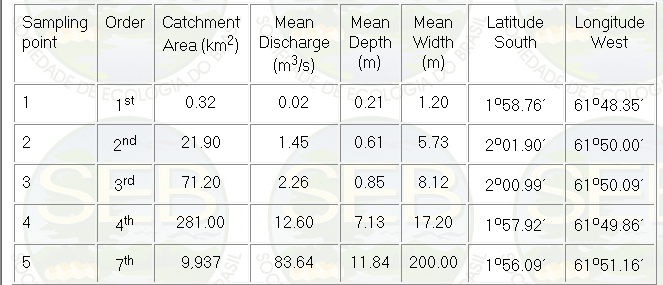
Sampling and Analysis
To investigate changes in community structure
related to stream size, aquatic macroinvertebrates were
sampled in 1st, 2nd, 3rd, 4th and 7th order tributaries
of the Jaú on four distinct occasions between March
and November of 1995. The geographic location of the sampling
sites is indicated in Table 1. Two complete meanders were
sampled in each tributary to assure that most common habitats
were represented. Different methodologies were used to
collect invertebrates, depending on tributary size and
invertebrate type, in order to obtain the most efficient
collection possible in all environments. A 1mm mesh hand
net was used to collect benthic invertebrates along the
complete study reach in 1st, 2nd and 3rd order streams.
These streams were small and shallow enough so that all
benthic environments present in the study reach could
be efficiently sampled with this method. Sampling effort
was optimized in these tributaries by plotting the cumulative
number of families encountered during the first collection
against sampling time (Fig 1). The optimal sampling interval
was defined as the minimum sampling time needed to saturate
the family curve. A standard sampling interval (> optimal
interval) of 15 minutes was used for all three stream
sizes. An Eckman dredge was employed to sample benthic
invertebrates in the deeper 4th and 7th order tributaries
where the use of a hand net was impractical. Due to the
greater length of these study reaches (0.5m - 2km) it
was not feasible to sample all existing habitats. Instead,
samples were collected along equidistant transects which
extended
between river margins (excluding wetlands)
perpendicular to the channel. The number of transects
sampled was optimized by plotting the cumulative number
of families encountered during the first collection campaign
against transect number. The minimum number of transects
necessary to saturate the family curve was adopted as
the standard sampling effort in each system. The standard
sampling effort determined in this manner for 4th and
7th order streams was 7 and 5 transects per reach, respectively.
Planktonic invertebrates (zooplankton) in all tributaries
were collected with a 65m m mesh zooplankton net. A single
100 hundred liter sample, collected near the surface at
mid channel
and mid reach, was filtered for each
tributary on each date. All benthic invertebrates larger
than 1mm were separated from detritus in the field and
preserved in 70% ethyl alcohol. Zooplankton samples were
preserved in 10% Formalin.
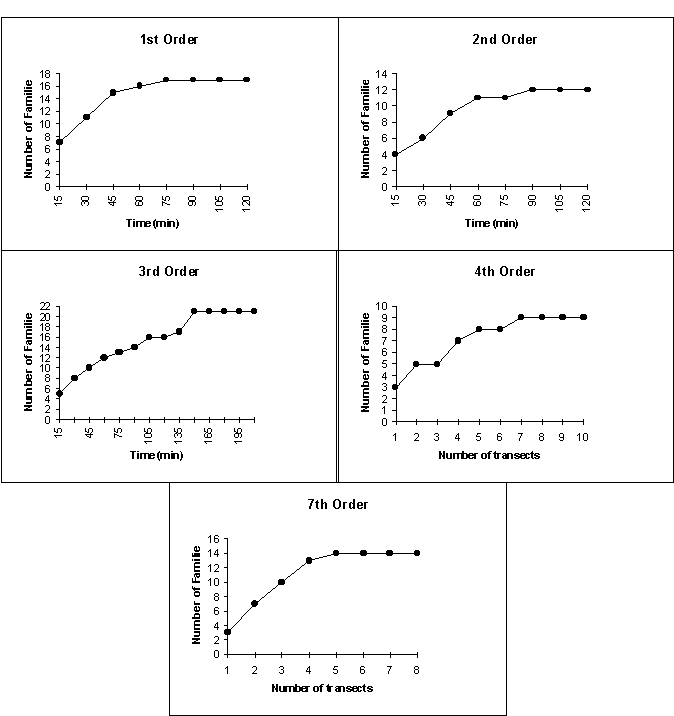
Figure 1. Cumulative number of families
encountered with increasing sampling time and transects
in tributaries of different size in the Jaú River
system.
All macroinvertebrates were identified
to the family level and classified into one of six recognized
functional feeding groups (9): shredders, collectors,
filterers, scrapers, omnivores or predators. The omnivore
group was included to account for organisms with multiple
feeding strategies which were not considered in the original
RCC model. The relative abundances of FFGs in each stream
were calculated from the total number of organisms in
each group encountered during the four collections. The
variation in relative abundance between collections was
not considered.
RESULTS AND DISCUSSION
Functional Feeding Group (FFGs) Distributions
The taxonomic composition of the macroinvertebrate
community in the Jaú river system (Table 2) was
similar to that found in other streams around the World.
All of the major invertebrate groups listed by Hynes (17)
as typical components of stream communities were found,
with a few exceptions. No amphipods or isopods were encountered.
Gastropods were also absent, probably due to the low concentrations
of calcium and other dissolved minerals, typically encountered
in blackwater streams (23). Another unique characteristic
of the Jaú’s invertebrate community was the
dominance of Palaemonidae (shrimps) in the Crustacea Group.
Freshwater shrimp are rare in north temperate streams
but quite common in small Amazonian tributaries. The taxonomic
composition of invertebrates in the Jaú was similar
to that reported for the Tarumã River, another
blackwater tributary of the Negro River (16, 32).
Table 2. Taxonomic and functional composition
of aquatic macroinvertebrates found in the Jaú
River system.
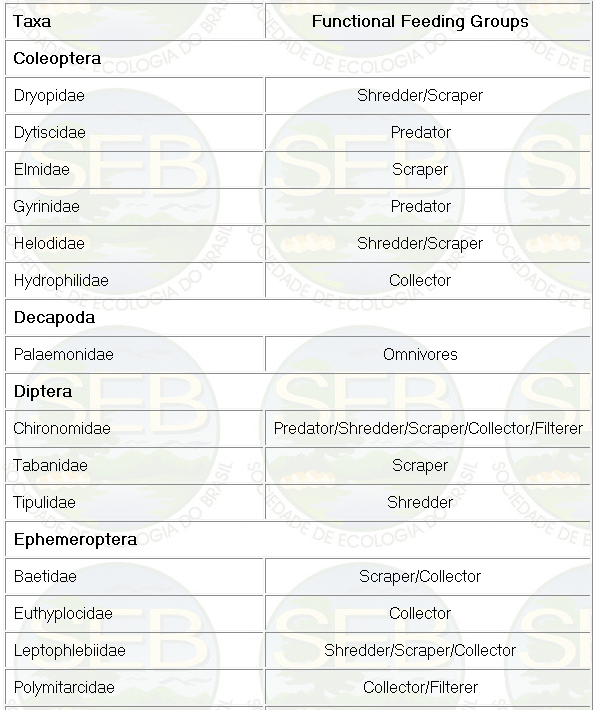
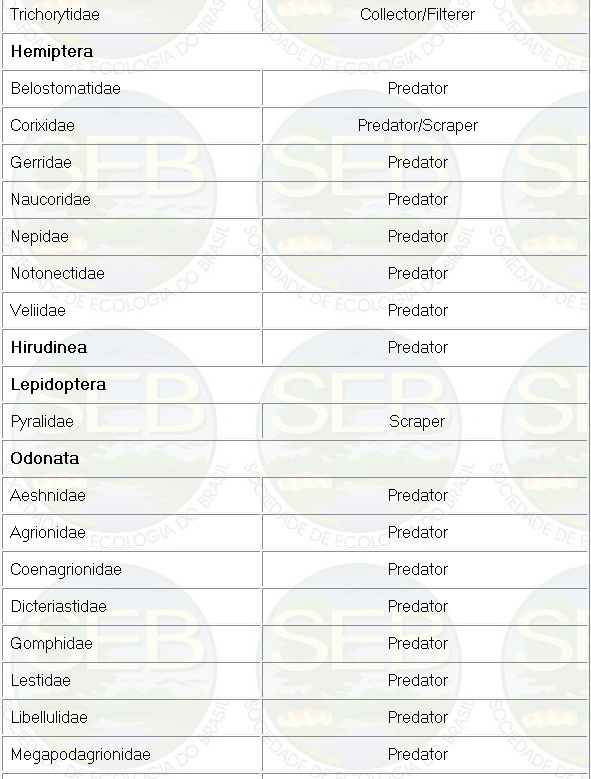
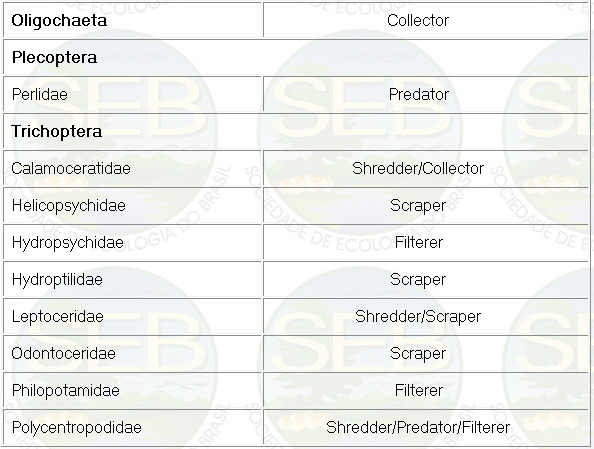
The variation encountered in the relative
abundances of FFGs with stream size is indicated in Figure
2. The similarity of these distributions to those predicted
by the RCC and their significance for ecosystem structure
and function are discussed below.
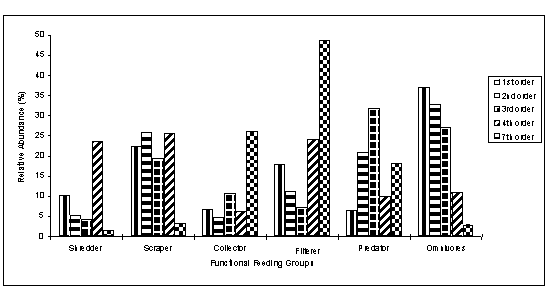
Figure 2. Relative abundance of macroinvertebrate
functional feeding groups in tributaries of different
size in the Jaú River system.
Shredders - With the exception of the
4th order tributary, the relative abundance of shredders
declined progressively with increasing stream size (Fig.
2). This trend, which is predicted by the RCC, has also
been encountered in many north temperate river systems
(15, 3), and apparently reflects the predominance of large
particulate organic matter, the main resource for this
group, in smaller order streams. The unusually high proportion
of shredders in the 4th order stream may reflect additional
inputs of fresh litter from fringing flooded forests,
a habitat that was not considered in Vannote et al.’s
(25) original RCC model. Adis et al. (1) encountered high
rates of litter production in black water flooded forests
of the Central Amazon. A large combined input of litter
inputs from this and upstream sources, together with the
existence of large log dams and slower current speeds,
apparently account for the large litter banks commonly
encountered in this environment. The greater proportion
of shredders in this tributary when compared to smaller
tributaries may also reflect the lower frequency of hydraulic
disturbance commonly encountered in higher order streams
(5). In another study involving a large number of low
order streams (< 3rd order) in the Jaú river
system, no significant correlation was found between the
abundance of shredders and litter and was attributed this
to between stream variation in flow disturbance (6). Increased
meander length and a lack of natural barriers in larger
order streams (> 5th order) apparently reduced the
residence time of leaf litter in these channels and prevented
litter bank formation.
Summing the results from all tributaries,
shredders accounted for 6.1% of all invertebrates collected
(Table 3). This is significantly lower than the proportion
of shredders commonly encountered in north temperate river
systems (~10%, (11)), but is similar to that encountered
in New Zealand (35, 36),in French (7) and in the Central
Amazonian streams (6). The low relative abundance of shredders
encountered in the Jaú river system may reflect
the lower food quality and higher levels of secondary
compounds commonly found in leaves from tropical forests
(18, 13).
Table 3. Absolute abundance of invertebrates
encountered in different functional feeding groups in
tributaries of different size in the Jaú River
system
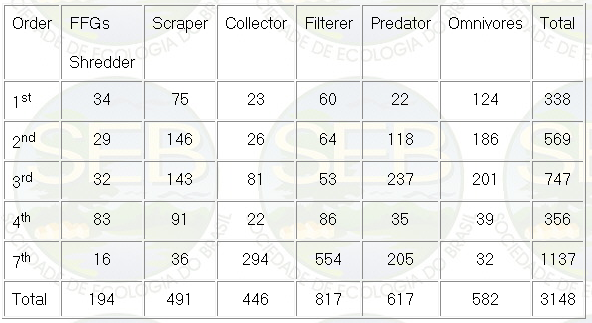 .
.
Scrapers: The relative abundance of this
group was consistently high in all stream sizes except
7th order (Fig. 2). This trend differed significantly
from that predicted by the RCC, where scraper abundance
is expected to peak in intermediate sized streams. The
distinct pattern, in this case, may reflect the use of
a different resource by this group. Scrapers are thought
to be feeding predominantly on periphytic algae attached
to benthic substrates (10, 22). Algal production is expected
to be highest in intermediate sized streams which are
wide enough to receive full incident radiation during
at least part of the day and shallow enough so that most
benthic surfaces are well illuminated. Fungi growing on
the surfaces of benthic litter is an alternative resource
for scrapers that can be quite important in many river
systems. Fungi can account for as much as 9% of total
detrital biomass in streams (14) and are exceptionally
high in food value (2). Walker (28) has argued that fungi
are the primary consumers of terrestrial leaf litter in
Amazonian streams and the first dominant link in aquatic
food chains of these systems. The production of fungi
presumably depends on the availability of fresh benthic
substrates which were plentiful in all study streams except
for the 7th order Jaú main channel. The use of
fungi by scrapers could thus explain the distribution
encountered for this group. The high contribution of scrapers
to total invertebrate numbers, 15.6% (Table 3), reflects
the relative importance of this group and the fungus-scraper
link to organic carbon flow in this system.
Collectors: The relative abundance of
benthic particle feeders varied considerably showing a
slight tendency to increase with stream size (Fig.2).
This trend contrasts with the decline in collector biomass
predicted by the RCC for larger streams and suggests that
fine benthic organic matter may be more abundant in these
tributaries than expected. The velocity of the Jaú
main channel is exceptionally low (mean = 0.15 m s-1),
especially when the mouth of the Jaú is flooded
by the rising Negro River (Forsberg et al., unpublished
data). Meade et al. (20) found that a significant part
of the fine organic sediment load of the Lower Amazon
was stored seasonally in the river channel when river
surface slope and velocity were reduced. A similar phenomenon
may also occur in the Jaú main channel, resulting
in a significant accumulation of fine benthic organic
matter during at least part of the year. The large numbers
of scrapers and shredders encountered in 4th order streams
(Table 3) may also provide a significant upstream source
of fine benthic organic matter for these larger channels.
No significant change was found in the collector density
with stream size in a large number of streams in the Jaú
river system. However he only examined small to intermediate
sized streams (6).
Filterers: The relative abundance of
planktonic particle feeders increased significantly in
the largest tributaries (Fig. 2) as predicted by the RCC
and observed in small North American streams (24). The
increase in filterers in larger tributaries was expected
due to the higher concentrations of suspended particles
encountered in these systems (Forsberg et al., unpublished).
The high percentage of filterers in small streams is more
difficult to explain. Wallace et al. (34) argued that
at the low current speeds common in most small streams,
planktonic filtration is extremely inefficient. However,
Walker (33) suggested that many filterers can also feed
by biting or sucking organic particles. This would allow
filterers to survive on both benthic and planktonic particles.
This hypothesis is supported by the results of Cargnin-Ferreira
(6) who found a strong positive relationship between the
densities of shredders and filterers in low order tributaries
of the Jaú River. This result suggested that filterers
could be feeding directly on the larger particles produced
by shredders. Yule (37) attributed the high proportion
of filterers (65%) which she encountered in a Papua New
Guinea river system to inputs of fine particulate organic
matter from riparian forests. Filterers were also the
largest functional group in the Jaú river system,
accounting for 26.0% of total invertebrate abundance (Table
3). The high representativity of this guild and the dominating
presence of riparian forests along low order tributaries
of the Jaú, suggest that the forest could be an
important source of fine particulate matter in this system,
as well.
Predators: In contrast to the homogenous
distribution of predators predicted by the RCC and encountered
in other systems (15, 12, 22, 3), the relative abundance
of this guild varied significantly with tributary size
in the Jaú (Fig. 2). When all non-predators were
considered as potential prey, absolute predator numbers
were positively correlated with prey numbers (Spearman
Rank, r = 0.90), suggesting that this variation was primarily
due to resource limitation. The exceptionally low prey:predator
ratios encountered in all tributaries (Table 4) and the
inverse correlation encountered between this ratio and
predator densities (Spearman Rank, r = - 0.7) tend to
support this hypothesis. Similar results were found in
a more extensive analyses of invertebrate communities
in low order tributaries of the Jaú (6). Not all
predator guilds in Amazonian streams though have been
found to be resource limited. Walker (29) encountered
a prey:predator ratio of 300 in the blackwater Tarumã
River and concluded that prey availability was not a limiting
factor for predators in this system. The higher prey:predator
ratio encountered in this case may have been due, in part,
to the different sampling method used. The author in this
study collected invertebrates by thoroughly washing submersed
litter, a procedure which allowed her to collect organisms
significantly smaller (<1mm) than those collected in
the present study. The greater selectivity of our sampling
method may have therefore resulted in a systematic underestimate
of prey abundance and resource availability for predators.
Predators were the second largest functional group, accounting
for 19.6% of total invertebrate abundance (Table 3).
Table 4. Prey/Predator and Prey/Omnivores
ratios encountered in tributaries of different size in
the Jaú River system.
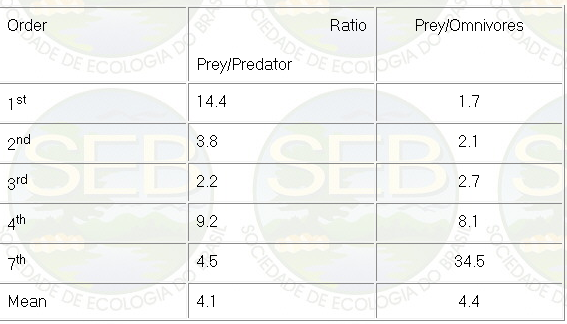
Omnivores: The only clear omnivores encountered
in the Jaú river system were freshwater shrimp
(Decapoda). Shrimp in Amazonian streams have been found
to consume algae and fungi attached to submersed litter
and also feed as predators on small fish and invertebrates
(19, 28, 30, 31). The distribution of shrimp, specifically,
and omnivores, in general, was not predicted by the RCC
(25). However, considering the feeding habits of shrimp,
tendencies similar to those encountered for predators,
collectors, filterers or scrapers might be expected. In
general, the relative abundance of shrimp decreased
progressively with stream size (Fig 2).
This pattern was similar to that encountered for shrimp
in a larger number of small order tributaries of the Jaú
(6) and resembles, in part, those encountered for shredders,
scrapers and filterers in the present study. The lack
of a positive correlation between the absolute abundances
of shrimp and total prey (all invertebrates except shrimp,
Spearman Rank, r = -0.10) and the existence of a positive
correlation between shrimp numbers and prey: omnivore
ratios (Spearman Rank, r = 0.70) suggest that prey-availability
is not a limiting factor for shrimp. The greater abundance
of shrimp in smaller streams suggests that fungi associated
with submersed litter may be a more important resource
for this group. The large concentrations of submerged
litter commonly found in small streams may also provide
an important refuge from large vertebrate predators (fish,
alligators). Large fish are rarely encountered in first
and second order streams but quite common in larger tributaries
and may effectively reduce shrimp densities in these environments.
Omnivores were the third most important functional group,
numerically, accounting for 18.5% of total invertebrate
abundance (Table 3). However, shrimp were the largest
macroinvertebrates in the system and probably accounted
for the majority of invertebrate biomass.
Ecosystem Structure and Function
As expected, the relative abundances
of most functional feeding groups varied significantly
with stream size in the Jaú River system. The specific
patterns encountered for several FFGs though were quite
distinct from those predicted by the RCC and these differences
have important implications for the structure and functioning
of this fluvial ecosystem.
In the ecosystem envisioned by Vannote
et al. (25), particulate allochthonous organic matter
enters the river system primarily in small order streams
in the form of coarse leaf litter. This material is processed
initially by shredders who reduce the material to smaller
particles and pass it along to a sequence of guilds further
downstream specialized in processing and reducing it even
further. The higher percentage of shredders observed here
in small order streams and the predominance of collectors
and filterers in high order streams (Fig.2) indicate that
a similar food chain may exist in the Jaú river
system. However the predominance of omnivores and scrapers
in small tributaries (Fig. 2) suggests that this is not
the dominant path of organic carbon flow.
In the RCC, scrapers are assumed to feed
predominantly on periphytic algae. In Amazonian streams
both scrapers and shrimp have been found to feed on fungi
as well (19, 16, 30). Most low order tributaries of the
Jaú (< 3rd order) are completely shaded by riparian
forest and periphyton growth is exceptionally low (Forsberg,
unpublished data). The most likely energy source for scrapers
and shrimp in these streams is therefore fungi attached
to submerged leaf litter. The dominance of scrapers and
shrimp in these environments thus suggests that fungi,
and not shredders, are the primary consumers of coarse
allochthonous particulate matter in the Jaú River
system. Henderson & Walker (16) and Walker (28) arrived
at a similar conclusion regarding organic carbon flow
in the Tarumã River, another blackwater tributary
of the Amazon. Based on meticulous in-vivo and in-vitro
observations of macroinvertebrate feeding behavior, she
identified fungi, associated with submerged leaf litter,
as the first link in the heterotrophic foodweb of this
system. The direct consumption of submerged litter by
shredders and other herbivores is apparently inhibited
by the low nutricional quality and high phenolic content
of tropical forest leaves (13). Fungi transform this basically
impalatable substrate into a nutritious, protein rich
food (i.e. fungal biomass) which is easily assimilated
by aquatic invertebrates. Once consumed by scrapers and
omnivores, fungi are either metabolized or transformed
into feces, providing a nutritious secondary resource
for particle collectors and filterers further down the
river size continuum.
Our results thus point to the existence
of two distinct pathways for the processing of allochthonous
particulate organic
matter in the Jaú River system:
1) a dominant pathway beginning with the colonization
and consumption of leaf liter by fungi and 2) a minor
pathway, similar to that proposed by other authors (25),
initiating with the consumption of submerged leaves by
shredders. An important characteristic of the shredder
pathway in the Jaú, that was not predicted by the
RCC, was the existence of large shredder populations in
fourth order streams (Fig. 2). These populations were
apparently sustained by lateral inputs of fresh leaf litter
from fringing floodplain forests, a habitat not included
in the original continuum model. Future refinements of
the RCC will clearly have to consider both fungal food
chains and allochthonous carbon inputs from floodplain
environments. Food quality also appeared to have an important
influence on the pattern of carbon flow in the Jaú
and will have to be considered in any model developed
to describe the trophic dynamics of tropical black water
river systems.
Implications for Management and
Conservation
The results described here have important
implications for the management and conservation of this
and other fluvial ecosystems in the Amazon region. The
functional inter-dependence of invertebrate communities
inhabiting different parts of the Jaú river continuum
make the system especially vulnerable to perturbation.
The impacts of anthropogenic or natural disturbances are
expected to be especially severe when they occur in headwater
streams. A disturbance which affects the integrity of
invertebrate communities in these tributaries is likely
to have a cascading impact on all interdependent communities
downstream, greatly altering the integrated structure
and functioning of the fluvial ecosystem. These impacts
are likely to effect not just invertebrate communities,
but all of the aquatic flora and fauna which depend on
them either directly or indirectly. The effects of deforestation
in headwater areas are likely to be especially devastating,
since litter inputs from headwater forests are the primary
source of allochthonous organic matter to the river system.
To maintain the structural and functional integrity of
the fluvial ecosystem, it is essential that these areas
be preserved in their natural state.
ACKNOWLEDGMENTS
We thank José Palheta and Gerley
Díaz Castro for help with field work and Dr. Ilse
Walker for constructive comments throughout the study.
This work was supported by the National Science Foundation,
Victoria Amazônica Foundation, INPA, NASA, and CNPq
(Brazilan National Research Council).
--------------------------------------------------------------------------------
RESUMO
Estrutura Trófica de Comunidades
de Macroinvertebrados no Sistema do Rio Jaú (Amazônia
Central, Brasil). O Conceito do Rio Contínuo (CRC)
provê uma linha teórica para o entendimento
da estrutura trófica e funcional do ecosistema
fluvial. Os grupos funcionais (GFs) de macroinvertebrados
têm uma importante função-chave nestes
sistemas, processando de forma semelhante classes específicas
de tamanho e tipos de recursos orgânicos. O CRC
faz previsões específicas sobre a distribuição
dos GFs ao longo do contínuo de tamanho do rio.
Nós apresentamos aqui, o primeiro teste dessas
previsões em um ecossistema fluvial neotropical,
o rio Jaú. As distribuições dos GFs
de macroinvertebrados aquáticos, determinadas ao
longo de um contínuo de tamanho do rio dentro da
bacia do rio Jaú, foram comparadas àquelas
previstas pelo CRC.
Os macroinvertebrados aquáticos
foram coletados em tributários do Jaú de
1a, 2a, 3a, 4a e 7a ordens, usando um esquema de amostragem
otimizado em quatro diferentes ocasiões entre março
e novembro de 1995. Como esperado pelo CRC, as abundâncias
relativas da maioria dos GFs variaram significativamente
com o tamanho do rio. Os padrões específicos
encontrados para muitos GFs entretanto, foram muito distintos
daqueles previstos pelo CRC. As comunidades nas cabeceiras
dos rios, as quais de acordo com o CRC seriam dominadas
por cortadores e coletores de partículas do bentos,
foram dominadas por raspadores e onívoros, aparentemente
consumindo fungos. A abundância relativa de predadores
, a qual é esperada ser constante no CRC, variou
consideravelmente entre os tributários no Jaú,
devido primeiramente às diferenças na disponibilidade
de presas. Duas rotas de processamento da matéria
orgânica particulada alóctone foram identificads
no sistema do rio Jaú: 1) uma rota dominante, iniciando
com a colonização e consumo de serrapilheira
por fungos e 2) uma rota menor, iniciando com o consumo
de folhas submersas pelos cortadores.
Palavras-chave: rio, macroinvertebrado,
grupos funcionais, Amazônia.
--------------------------------------------------------------------------------
REFERENCES
Adis, J.K.; Furch, K; Irmler, U. Litter
production of a Central Amazonian inundation forest. Trop.
Ecol. 20:236-245, 1979.
Bärlocher, F.; Kendrick, B. Dynamics of the fungal
population on leaves in a stream. J.Ecol. 72: 761-791,
1974.
Basaguren, A.; Elosegui, A.; Pozo, J. Changes in the trophic
structure of benthic macroinvertebrate communities associated
with food availability and stream flow variations. Hydrobiol.
81: 79-91, 1996.
Braioni, M.G. Faunistic research in a fluvial ecosystem
study: the case of the River Adige. Boll. Zool. 61:415-424,
1994.
Brussock, P.P.; Brown, A.V. Riffle-pool geomorphology
disrupts longitudinal patterns of streams benthos. Hydrobiol.
220: 109-117, 1991.
Cargnin-Ferreira, E. Fatores influindo na distribuição
de grupos funcionais de macroinvertebrados aquáticos
em pequenos tributários do rio Jaú, Amazônia
Central. Manaus, 1998, 65 p. (M.S. Thesis, Curso de Ecologia,
INPA).
Chauvet, E.; Giani, N.; Gessner, M.O. Breakdown and invertebrate
colonization of leaf litter in two contrasting streams:
significance of oligochaetes in large river. Can. J. Fish.
Aquat. Sci. 50: 488-495, 1993.
Culp, J.M.; Davies, R.W. Analysis of longitudinal zonation
and the River Continuum Concept in the Oldman-South Saskatchewan
river system. Can. J. Fish. Aquat. Sci. 39: 1258-1266,
1982.
Cummins, K.W. Trophic relations of aquatic insects. Ann.
Rev. Entomol. 18: 183-206, 1973.
Cummins, K.W.; Klug, M.J. Feeding ecology of stream invertebrates.
Ann. Ver. Ecol. Syst. 10: 147-172, 1979.
Cummins, K.W.; Wilzbach, M.A.; Gates, D.M.; Perry, J.B.;
Taliaferro, W.B. Shredders and riparian vegetation. Leaf
litter that falls into streams influences communities
of stream invertebrates. BioSci. 39: 24-30, 1989.
Dudgeon, D. Longitudinal and temporal changes in functional
organization of macroinvertebrate communities in Lam Tsuem
River, Hong Kong. Hydrobiol. 111: 207-217, 1984.
Forsberg, B.R.; Devol, A.H.; Richey, J.E.; Martinelli,
L.A.; Victoria, R.L.; Bonassi, J.A.. Autotrophic arbon
sources for fish of the Central Amazon. Ecol. 74: 643-652,
1993.
Gessner, M.O.; Schoerbel, J. Fungal biomass associated
with leaf litter in a stream. Oecol. 87: 602-603, 1991.
Hawkins, C.P.; Sedell, J.R. Longitudinal and seasonal
changes in functional organization of macroinvertebrate
communities in four Oregon streams. Ecol. 62: 387-397,
1981.
Henderson, P.A.; Walker, I. On the leaf
litter community of the Amazonian blackwater stream Tarumazinho.
J. Trop. Ecol. 2: 1-17, 1986.
Hynes, H.B.N. The Ecology of Running Waters. Liverpool
University Press. Liverpool, 1970, 555p.
Janzen, D. H. Tropical blackwell rivers, animals, and
mast fruiting by the Dipterocarpaceae. Biot. 6: 69-103,
1974.
Kensley, B.; Walker, I. Palaemonid shrimps from the Amazon
basin, Brasil (Crustacea: Decapoda: Natantia). Smithsonian
Contributions to Zoology. Whashington, 1982, 362, 28p.
Meade, R.H.; Dunne, T.; Richey, J.E.; Santos, U.M.; Salati,
E. Storage and remobilization of suspended sediment in
the lower Amazon River of Brazil. Sci. 228: 488-490, 1985.
Minshall, G.W. Autotrophy in stream ecosystems. BioSci.
28: 767-771, 1978.
Riaño, P.; Basaguren, A.; Pozo, J. Variaciones
espacio-temporales de las comunidades de macroinvertebrados
bentónicos del río Agüera (País
Vasco-Cantabria). Limnet. 9: 19-28, 1993.
Schmidt, G.W. Chemical properties of some waters in the
tropical rain forest region of Central Amazonia. Amazon.
3: 199-207, 1972.
Smock, L.A.; Gilinsky, E.; Stoneburner, D.L. Macroinvertebrate
production in a southeastern United States blackwater
stream. Ecol. 66: 1491-1503, 1985.
Vannote, R.L., Minshall, G.W., Cummins, K.W., Sedell,
J.R.; Cushing, C.E. The river continuum concept. Can.
J. Fish. Aquat. Sc., 37: 130-137, 1980.
Walker, I. Rede de alimentação de invertebrados
das águas pretas do sistema do rio Negro. 1. Observações
sobre a predação de uma ameba do tipo Amoeba
discoides. Ac. Amazon. 8: 423-438, 1978.
Walker, I. On the structure and ecology of the micro-fauna
in the Central Amazonian forest stream ‘Igarapé
da Cachoeira’. Hydrobiol. 122: 137-152, 1985.
Walker, I. The biology of streams as part of Amazonian
forest ecology. Exp. 43: 279-287, 1987.
Walker, I. Study of benthic micro-faunal colonization
of submerged litter leaves in the central Amazonian black-water
stream Tarumã-Mirim (Tarumazinho). Ac. Limnol.
Brasil. 2: 623-648, 1988.
Walker, I.; Henderson, P.A.; Sterry, P. On the patterns
of biomass transfer in the benthic fauna of an Amazonian
black-water river, as evidenced by 32P label experiment.
Hydrobiol. 215: 153-162, 1991.
Walker, I. Life history traits of shrimps (Decapoda: Palaemonidae)
of Amazonian inland waters and their phylogenetic interpretation.
Stud. Neotrop. Fauna Environ. 27: 131-143, 1992.
Walker, I. The benthic litter-dwelling macrofauna of the
Amazonian forest stream Tarumã-Mirim: patterns
of colonization and their implications for community stability.
Hydrobiol. 291: 75-92, 1994.
Walker, I. Amazonian streams and small rivers in: Tundisi,
J.G.; Bicudo, C.E.M. e Matsumura-Tundisi, T. (eds.). Limnology
in Brazil. Rio de Janeiro, 1995, p.167-193.
Wallace, J.B.; Webster, J.R.; Woodal, W.R. The role of
filter feeders in flowing waters. Arch. Hydrobiol. 79:
506-532, 1977.
Winterbourn, M.J.; Cowie, B.; Rounick, J.S. Food resources
and ingestion patterns of insects along a West Coast,
South Island, river system. N. Z. J. Mar. Freshwat. Res.
18: 43-51, 1984.
Winterbourn, M.J.; Rounick, J.S.; Cowie, B. Are New Zealand
stream ecosystems really different? N. Z.J. Mar. Freshwat.
Res. 15: 321-328, 1981.
Yule, C.M. Trophic relationships and food webs of the
benthic invertebrate fauna of two aseasonal tropical streams
on Bougainville Island, Papua New Guinea. J. Trop. Ecol.
12: 517-534, 1996.

